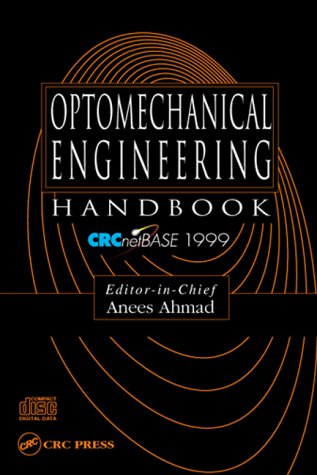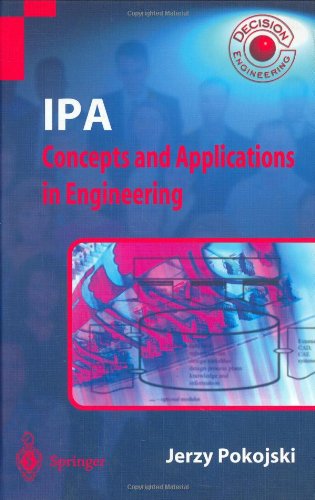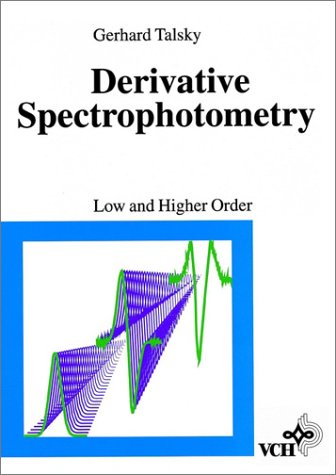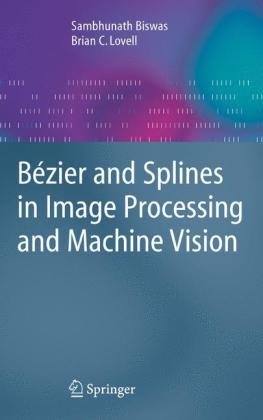Anees Ahmad9780849397530, 0849397537
Table of contents :
Contents……Page 2
What Is Optomechanics?……Page 6
Contents……Page 0
Role of Optomechanical Design and Its Significance………Page 7
Image Position and Magnification……Page 8
Amount of Light Through a Lens System……Page 11
Additional CAD Techniques for Design and Ray Traci………Page 13
ISO and ANSI Drafting Standards……Page 14
Mechanical Drawing Standards……Page 15
Optical Drawing Standards……Page 17
1.4 Dimensional Tolerances and Error Budgets……Page 19
Base Costs……Page 20
Milling/Generating Costs……Page 21
Grinding and Polishing Costs……Page 24
Effect of Tolerances and Other Factors on Costs……Page 26
Total Lens Cost Estimation……Page 29
Lens Centering……Page 31
Lens Tilt and Roll……Page 32
Assigning Tolerances for Minimum Costs — An Exampl………Page 34
Simplifying Approximations……Page 35
Derivatives of Costs with Respect to Tolerances……Page 37
Tolerance Allocation Process……Page 39
Tolerancing Summary……Page 42
Survivability under Temperature, Vibration, and Sh………Page 43
ISO 9022 — Environmental Test Methods……Page 44
ISO 10109 — Environmental Requirements……Page 46
Summary of Environmental Effects……Page 47
2.2 Service Environments……Page 50
2.3 Structural Design……Page 51
2.4 Kinematic Design……Page 56
2.5 Athermalization……Page 60
2.6 Vibration Control……Page 67
Refractors……Page 75
Reflectors……Page 76
Structural Components……Page 77
Mechanical……Page 78
Thermal……Page 80
Properties of Refractive Materials……Page 81
Glasses……Page 82
Crystals and Semiconductors……Page 83
Plastics……Page 85
Properties of Mirror and Structural Materials……Page 87
Structural Adhesives……Page 88
Optical Cements……Page 89
3.4 Material Selection Criteria……Page 92
3.5 Summary……Page 93
4.1 Introduction……Page 96
4.2 Dimensional Stability……Page 97
Other Instabilities……Page 98
Sources of Dimensional Change……Page 99
External Stress……Page 100
Changes in Internal Stress……Page 101
Microstructural Changes……Page 105
Inhomogeneity/Anisotropy of Properties……Page 106
Promoting Dimensional Stability……Page 107
Aluminum and Aluminum Matrix Composites……Page 108
Beryllium……Page 109
Invars……Page 110
Silicon Carbide……Page 111
4.4 Fabrication Methods and Lightweighting……Page 112
Other Metals……Page 113
Reaction Bonded……Page 114
4.5 Summary……Page 115
5.1 Introduction……Page 119
5.2 Estimating Mirror Weight……Page 120
5.3 Mirror Self-Weight Deflection…….Page 122
5.4 Contoured Back Mirrors……Page 128
5.5 Sandwich Mirrors……Page 135
5.6 Open-Back Mirrors……Page 146
5.7 Comparison of Mirror Performance……Page 151
6.1 Introduction and Summary……Page 160
Snap Ring……Page 161
Burnished Cell……Page 162
Retaining Ring Mounts……Page 163
Clamping (Flange) Ring……Page 164
Sealing Techniques……Page 165
General Considerations……Page 166
The “Sharp Corner” Interface……Page 167
The Tangential Interface……Page 168
The Toroidal Interface……Page 169
Parametric Comparisons of Interface Types……Page 170
Effects of Changing Materials……Page 172
Rate of Change of Preload with Temperature……Page 175
Growth of Axial Clearance at Increased Temperature………Page 177
Bending Stress Due to Preload……Page 178
The Cemented Doublet……Page 179
The Air-Spaced Doublet……Page 180
General Formulation for Multiple Elements……Page 182
Tangential Hoop Stress within the Cell Wall……Page 183
First-Order Thermal Effects……Page 184
“Drop-In” Assembly……Page 185
“Lathe” Assembly……Page 186
Modular Assembly……Page 189
Elastomeric Assembly……Page 190
Operational Motions of Lenses……Page 193
Sealing Considerations……Page 196
General Considerations……Page 198
Examples of Simple Window and Filter Mounts……Page 199
Example of A Larger Window Mount……Page 201
Examples of Shell and Dome Mounts……Page 202
Pressure Differential Effects……Page 203
Thermal Effects……Page 204
Clamped Mounts……Page 206
Bonded Mounts……Page 207
Flexure Mounts……Page 209
Kinematic and Semikinematic Techniques……Page 211
Nonkinematic Techniques……Page 213
Examples of Cantilevered Techniques……Page 214
Examples of Multiple Support Techniques……Page 215
Flexure Mounts……Page 216
7.1 Introduction……Page 221
General Description……Page 222
Interfaces for Linear Mechanisms……Page 223
Hydrostatic Bearings for Linear Mechanisms……Page 224
Flexures for Linear Mechanisms……Page 225
Actuators for Linear Mechanisms……Page 227
Motorized Actuators……Page 228
Manual Actuators……Page 230
Coupling Methods for Linear Mechanisms……Page 232
Preloading Methods for Linear Mechanisms……Page 233
Locking Methods for Linear Mechanisms……Page 235
Examples of Linear Translation Mechanisms……Page 236
Lens Centration and Focus Mechanisms……Page 241
Interfaces for Tilt Mechanisms……Page 245
Locking Methods for Tilt Mechanisms……Page 248
Examples of Tilt Adjustment Mechanisms……Page 249
Interfaces for Rotary Mechanisms……Page 253
Actuators for Rotary Mechanisms……Page 254
Coupling Methods for Rotary Mechanisms……Page 255
Preloading Methods for Rotary Mechanisms……Page 257
Examples of Rotary Adjustment Mechanisms……Page 258
7.6 Design Guidelines for Adjustment Mechanisms……Page 260
7.7 Summary……Page 262
Structural Analysis of Optics……Page 265
Derivation of Stiffness Matrix……Page 266
Axisymmetric Solids (TRIAX6)……Page 268
Equation Element (MPC, RBE3)……Page 269
Element Accuracy……Page 270
8.3 Symmetry Techniques……Page 273
Axisymmetry……Page 274
Reflective Symmetry with General Load……Page 275
Reflective Symmetry with Symmetric Load……Page 277
Full Model (360°)……Page 278
Half-Model (180°)……Page 279
Quarter Model (90°C)……Page 280
Advantages and Disadvantages of Symmetry……Page 282
Single-Point Model (Solid or Lightweight Optic)……Page 283
3D Solid Model (Solid Optic)……Page 284
2D Equivalent Stiffness Plate Model (Lightweight O………Page 285
3D Equivalent Stiffness Solid Model (Lightweight O………Page 288
3D Plate Model (Lightweight Optic)……Page 289
Comparison of Models (Lightweight Optic)……Page 291
Ductile Failure (Most Metals)……Page 293
Fracture Mechanics Approach……Page 296
Model Detail Around Stress Conditions……Page 297
Stress Plots……Page 298
8.6 Adhesive Bond Analysis……Page 299
Material Relationships……Page 301
Option 1: Detailed 3D Solid Model……Page 304
Option 2: Coarse 3D Solid Model……Page 305
Option 4: Equivalent Spring Model……Page 306
Bond Joint Failure Analysis……Page 307
Determinate Structures……Page 308
Zero G Test Supports……Page 311
Metering Structures……Page 313
Polynomials……Page 315
Surface Fitting……Page 317
Interpretation……Page 319
Image Motion Calculation……Page 320
Optical Pathlength Calculation……Page 324
8.10 Ray Tracing……Page 325
8.11 Model Checkout……Page 328
8.12 Optimum Design……Page 330
Design Sensitivity……Page 331
Design Constraints……Page 332
Lighweight Mirror Design Issues……Page 333
Shape Optimization……Page 334
8.13 Summary……Page 336
Notations……Page 339
Modes of Heat Transfer……Page 340
Conduction……Page 341
Radiation……Page 344
Solution Methods……Page 345
Two-Dimensional Models……Page 347
Three-Dimensional Models……Page 348
9.4 Interpolation of Temperature Field……Page 349
Interpolation via Shape Functions……Page 350
Distortions and Stress……Page 353
Rigid Element Problems……Page 354
CTE Spatial Variation……Page 355
Model Type 1: Effective Gradient……Page 356
9.6 Analogies……Page 357
Structural–Thermal……Page 358
Moisture Absorption……Page 359
Temperature-Dependent Index of Refraction……Page 360
9.7 Summary……Page 362
10.1 Introduction……Page 364
10.2 Fabrication Method Selection……Page 365
Product Requirements……Page 366
Personnel Capabilities……Page 368
Make Vs. Buy Decisions……Page 370
Optical Component Machining……Page 371
Replication Methods……Page 373
Cast Optical Components……Page 374
Matrix Metals/Graphite/Organics……Page 375
Design Considerations……Page 376
Filament Winding Processes……Page 377
Assembly Methods and Facilities……Page 378
Inspection……Page 379
Material Selection……Page 380
Refractive Optical Materials……Page 381
Ceramic Materials……Page 382
Cost Comparisons……Page 383
Design Criteria for Dimensional Stability……Page 384
Stress — Internal to the Material or Intrinsic Str………Page 386
Strengthening Mechanisms……Page 387
Precipitation-Hardened Metals……Page 388
Stabilization of Selected Advanced Materials……Page 389
10.6 Chemical and Vacuum Coating Processes in Opti………Page 390
Aqueous Coating Processes……Page 391
Electroless Nickel……Page 392
Electrolytic Deposits……Page 393
10.7 Summary……Page 394







Reviews
There are no reviews yet.